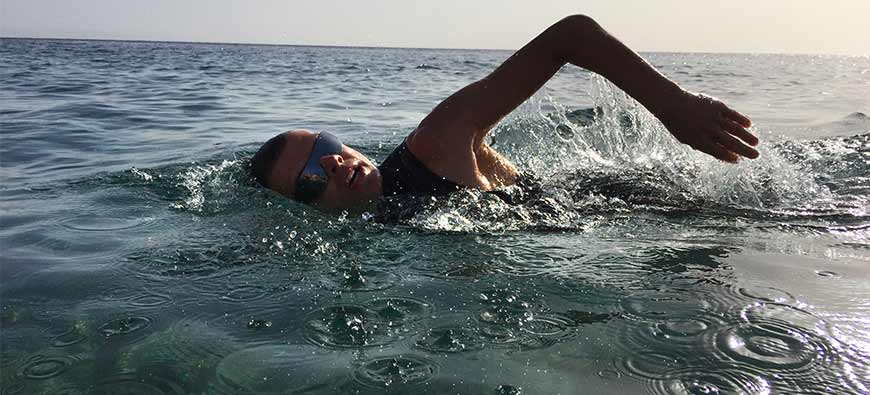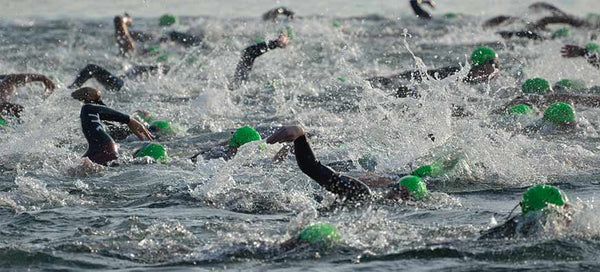Free Shipping plus 9% off Wetsuits. Use Code: DIVE9
Views: 8 Author: Site Editor Publish Time: 2020-12-06 Origin: Site

If you've been swimming all your life and have competed at all levels in an indoor pool, you probably already know how exciting it can be for a swimmer to change lanes in a pool for the immense ocean waters, without limits and totally exposed to the climatic changes of the high seas. It is impossible for a pool swimmer to succeed and adapt to swimming in open water? Of course not, everything is possible with good preparation. However, at first the change can be overwhelming and cause more than one problem among beginner swimmers of this demanding modality of swimming.
Open water swimming is a water sport full of emotion that causes thousands of athletes addicted to strong emotions and adrenaline rush to try it and seek to beat their own records by swimming in the open sea, against wind and tide and exposed to all kinds of temperature changes and weather setbacks that no one can control while they are swimming. Once you have started swimming, the only thing between the finish line and you will be the sea, an immense sea that many times can be too frightening for those who are not used to it and causes them to leave early.
And what is the best way to prevent this? By preparing yourself properly and working on the weak points of each swimmer. That is why we are going to give a small essential guide so that the beginners of the swimming in open waters know how to prepare themselves properly for the change of mode, to improve their adaptation to the waters and which are the main weak points that they will have to work on so that they do not end up giving up before time and not being able to enjoy the emotion of swimming in the middle of the ocean.

Ready to know everything about how to start swimming in open water swimming?
Read on!
One of the main mistakes pool swimmers make is to believe that the one-sided breathing pattern they usually use to swim in the straight lanes of their pools will serve them well for swimming in open water. And why? Because unlike a pool where the water doesn't move, it's always the same temperature and there are no gusts of wind to make it change direction, in open water all the possible unforeseen events you can imagine while swimming come true: the water constantly changes direction, you can find yourself with waves that are higher than others that force you to hold your breath or it can even start raining.
All this makes your breathing pattern irregular, often causing the fear and anxiety of the most inexperienced swimmers who are powerless against the force of the tide and nature. And what is the best way to prevent these panic attacks and learn to breathe against the tide? Start training with a virtually perfect alternating breathing pattern. For example, start swimming by breathing three times to the left and six times to the right, then eight times to the left and four times to the right, and even stop breathing between strokes to be more prepared if at some point the water hits your face and doesn't allow you to breathe.
Believing that everything we do in the pool will help us swim in open water is a serious mistake that as beginners we should try to make from the beginning. The sea is immense and beautiful, but it can also become your worst enemy if you don't prepare yourself properly to dive into it, don't forget.
What is the maneuver that any swimmer must learn from a young age in order to win an indoor pool race? The turns on the wall of the pool. In indoor pools we have lanes and walls that serve as a reference to know when to swim faster, when to slow down and when to prepare to turn around and push against the wall. In open water all those references disappear and of course there are no walls, we will only have some flags that will indicate the end of each section.
How then to practice the turns? Well, the only way that these turns in open water will not be so difficult for you because you do not have the help of a wall, is to start training in a large pool trying to imitate this game of movements without the wall. You could also train at sea but the best way to perfect the movements without complications is to practice everything in a pool first.
After all, turning movements are something we do from our muscle memory, so now all we have to do is memorize a whole new sequence of movements to be able to successfully perform our turns in the open water.
The best way to face open water training with all the guarantees of success is working your endurance and being able to do the full distance of the course in open water without stopping inside a pool. A kilometer in open water is not the same as a kilometer in a completely calm and acclimatized pool, so having a great resistance will allow you to endure the usual changes in pace that usually occur while swimming outdoors: wind, rain, waves, etc.
The greater your resistance in the pool, the better prepared you will be to swim in open water without so many complications. You have to keep in mind that sometimes in open water a simple stretch of barely 100 meters in distance, becomes an odyssey through the waves or rain, taking you more than 10 minutes to go through it and making you spend twice as much energy as you would need for that distance inside a simple pool.
Another trick that experts in open water swimming advise so that beginners don't end up exhausted is to practice what is called "resting in motion". This practice consists of continuing to swim at the same pace but reducing by half the strength and intensity we invest in our strokes, which will make us save energy for other stretches that require greater resistance on our part.
Many open water trainers claim that the key to success in open water swimming is our ability to relax and to be able to breathe properly. One of the main disadvantages of this sport is the temperature of the sea water, which depends on several factors: time of year, geographical location and size of the water body.
Because of this variation in water temperature, our body usually suffers a great thermal shock when it is immersed in sea water, either in winter or summer, since it will normally be between 20 and 10 degrees (sometimes even less) and this will cause all the muscles in our body to tense up and our breathing to be irregular and shallow. Now, regardless of what our body may physically suffer, the consequences that this temperature shock will have on our brain will be much more important and will be the ones we will have to work on so that they do not end up ruining all our physical preparation. And how is this done? By teaching our body to relax in that situation.
A good trick to prepare ourselves for such an extreme situation is to start taking baths in cold water, simulating the temperature that will be in the sea and practicing our breathing as we would do while swimming. This is a good way to get used both physically and mentally to the sudden change in temperature that swimming in open water entails, since even if we wear a wetsuit we will still feel the cold and find it just as distressing to swim.
Although throughout this article we have made it more than clear that training in a pool has nothing to do with doing it in open water, using it to perfect your technique and your resistance is the best option you will have. The reason why it is not better to train directly in open water? Because in a pool you will be able to perfect your endurance and simulate all the maneuvers without having to fight the wind, fatigue and tide; something that will be of great help if you want to arrive with strength to the day of the competition.
Training three to four times a week in your usual pool to get stronger and gain resistance will help you arrive prepared, because although it is not the same and the conditions are much more pleasant, we will be training much longer distances and at a much higher intensity level. On the other hand, there are open water trainers who prepare their swimmers using some tricks that will help them adapt better to the change, such as using immobilizing bands on the ankles that will increase the rotation of the arms and will make them gain strength in the upper body; something essential to withstand the scourge of the waves and the wind.